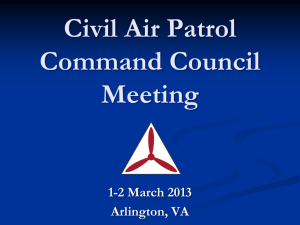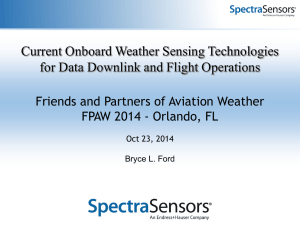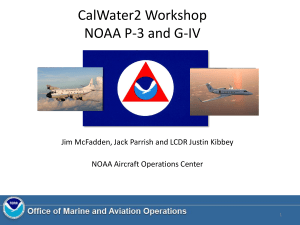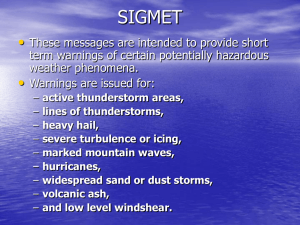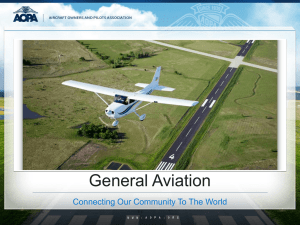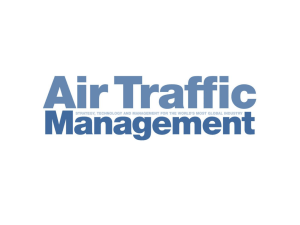The Potential of Reporting MET Parameters from Aircraft
advertisement
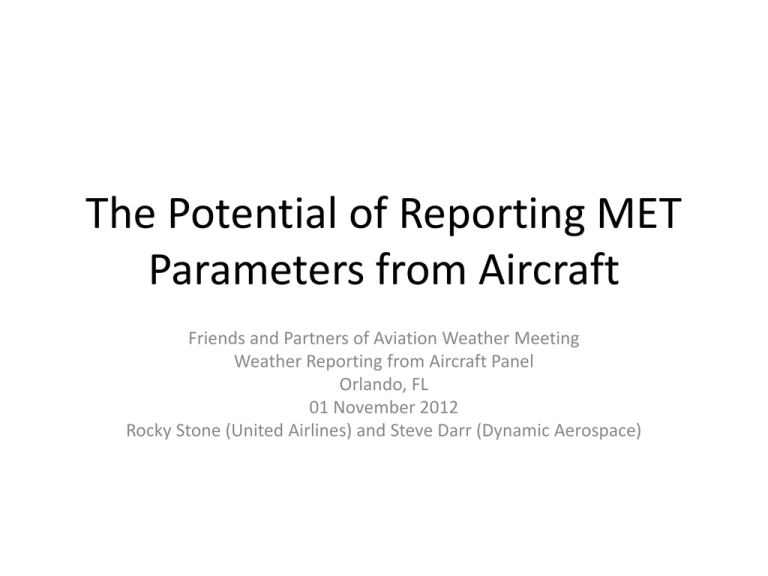
The Potential of Reporting MET Parameters from Aircraft Friends and Partners of Aviation Weather Meeting Weather Reporting from Aircraft Panel Orlando, FL 01 November 2012 Rocky Stone (United Airlines) and Steve Darr (Dynamic Aerospace) Discussion Themes • Something to think about… • Historical precedent, demand, and opportunity • Weather and Aviation • Proposed service • Existing, planned, and potential applications • Data link options and ADS-B advantages • Final Note WHAT IF… ? Think about… … what high quality, low latency, high density, readily available MET data would allow the weather community to do? – Think about what telecommunications, interstate highways, and the internet enabled – Think about the before and after None of these services were built on the strength of a single application, nor was their potential accurately imagined at their outset HISTORICAL PRECEDENT, DEMAND, AND OPPORTUNITY It’s not a new question… • The NWS was established to collect data from far flung locations to support efforts to protect life and property – The ability to simultaneously observe weather in multiple, remote locations and collect and display it rapidly in one location (enabled by the telegraph) permitted the advancement of operational meteorology and the advent of forecasting • Today, thousands of weather observations are made hourly and daily by government agencies, volunteer observers, ships, planes, automatic weather stations, and earthorbiting satellites in support of the same mission today – What if hundreds of thousands of observations were available? – What if they were widely available in near real-time? Shifting Provider Paradigm Government Weather Service • Once the nation’s only civilian weather source • Then the sole owner of tools to: – Collect observations – Collate the data and assemble the information – Develop and issue weather forecasts Commercial Weather Industry • More than 50 years of competitive pressure and innovation • Providing value-added, tailored weather information for: – Individual users – Businesses and industry – Government and the media Evolving Weather Product Demand • Weather related damage totals ~$20 Billion per year and estimates show up to $3 Trillion of the economy is affected annually by weather and climate events • Rapid advancement in weather and climate products is being fueled by: – – – – Increasing availability and speed of communications Declining costs Opportunities to innovate Increasing demand for rich weather content A Revolutionary Opportunity? • Communications advances – Supports both collection and distribution – Geospatial, temporal, and individual tailoring • Observation advances – Lower cost, higher performance sensing systems, many with real-time connectivity – NOAA Meteorological Assimilation Data Ingest System (MADIS) – TAMDAR, AMDAR, and MDCARS • High Resolution Forecasting and Mesoscale Data Assimilation Advances – 3D and 4D variational data assimilation tools (3DVAR, 4DVAR) provides greatly improved synoptic scale performance which improves mesoscale performance – Limited area operational models provide increased resolution with local features represented, from convection to topographic flows – Ensemble Kalman filter data assimilation improved mesoscale performance • Nowcasting- predicting the evolution of the environment over only several hours- could prove advantageous if operations can be effected by it WEATHER AND AVIATION Aviation Weather • FAA relies on NWS to provide weather information and forecasts supporting NAS operational decision making • Operators, whether they use government or commercial weather products, rely on NWS for base observation information that feeds products – Aviation operators provide a portion of the base observation information to the NWS – Aviation operators are beginning to use the observation information they collect to independently improve their operations directly Aviation System Performance • In aviation, NextGen and SESAR anticipate using realtime weather to safely separate aircraft and permit operators to adapt flight plans to operate more efficiently and safely • Trajectory and Trajectory-based Operations plans and operational imperatives are at odds – Safe separation depends on 4D trajectory conformance – Navigation can (inefficiently) correct for theoretical location errors introduced by wind and temperature prediction errors – Aircraft performance may not and business models likely won’t support inefficient speed requirements introduced by wind and temperature prediction inaccuracies PROPOSED SERVICE Atmospheric Data Elements: transmitted to characterize atmosphere Aircraft Derived MET Data Service RTCA DO-339, “Aircraft Derived Meteorological Data via Data Link for Wake Vortex, Air Traffic Management, and Weather Applications”, proposes a data delivery service that transmits aircraft derived meteorological data for the purpose of improving aviation operations capacity, safety, and efficiency. The proposed data delivery service would geospatially and temporally characterize the atmosphere, in the Airport and Terminal Maneuvering Area (at 50’ altitude change intervals or 1 NM intervals in level flight) and En Route (at 500’ altitude change intervals or 5 NM intervals in level flight). Multiple data elements are envisioned as being transmitted in different message classes. Wind Speed Wind Direction Static Pressure Static Temperature Eddy Dissipation Rate Humidity/ Water Vapor Hazardous Weather Data Elements: transmitted On Condition Wind Shear Microburst Icing Peak Turbulence Aircraft Surveillance Data Elements: transmitted at rates suitable for use in real-time decision support tools and for video depiction Position Altitude Track Heading Vertical Rate True Airspeed Mach Number Aircraft Data Elements: transmitted in conjunction with atmospheric data elements Aircraft ID Aircraft Type Weight Wing Span Aircraft Configuration Wake Vortex Initial Circulation Strength EXISTING, PLANNED, AND POTENTIAL APPLICATIONS AC Weather Data Links & Applications • Meteorological Data Collection and Reporting System (MDCRS) – Up to 100,000 observations/day collected as inputs to NWS predictive weather models • • • • • Aircraft Meteorological Data Relay (AMDAR) Tropospheric Airborne Meteorological Data Reporting (TAMDAR) Automatic Dependent Surveillance- Contract (ADS-C) Mode S Enhanced Surveillance (EHS) Some applications that already use this data – – – – ADDS RAPid Refresh AirDat real-time weather forecasting, alerting, and decision support Boeing-KLM to KNMI to LVNL for trajectory prediction Planned and Potential Applications • Separation functions – Trajectory ops and Trajectory-based operations – Delegated interval management operations • Beyond in-trail procedures, e.g. merging at a future time, point – Wake turbulence avoidance • Strategic flow functions – Trajectory ops and Trajectory-based operations – Wind and temperature based • Flight route optimization • Track system optimization • Weather functions – Observation – Forecasting – Basic Atmospheric Science SC-206 OSED, ConUse Applications • Wake Turbulence Avoidance – – – – – – • Air Traffic Management – – – – • CSPR solutions Single Runway solutions En route avoidance advisor Dynamic pairwise separation On board avoidance Wake Vortex Safety Systems Traffic Flow Management Conflict Detection and Resolution Automation Optimized Arrivals Separation Assurance Weather – Observation, Reporting, and Forecasting of: • • • • • Wind and temperature Atmospheric Pressure Atmospheric Turbulence Humidity and Water Vapor Hazardous Weather DATA LINK OPTIONS AND ADS-B ADVANTAGES Data Link Options Data Transmit Options • Aircraft to Ground and Aircraft to Aircraft – Broadcast – Demand (interrogate-reply) – Contract (triggered) Data Distribution • Ground to Air and Ground to Ground Possible Link Standards • VDL Mode 0/A, 2, 3, 4 – – • • • VHF Data Broadcast (VDB) HFDL ADS-B – – • • • 3G CDMA/ EvDO Rev A, Rev B GSM/GPRS, LTE Advanced (4G) SatCom – – • UAT (978 MHz) Mode S (1090 MHz) Mode S EHS ADS-C Cellular – – • ACARS ATN Dedicated systems Wide area networks Terrestrial WLAN/ WWAN ADS-B Advantages • Broadcast data link – Air to ground – Air to air • Existing ground infrastructure – Ground to ground – Ground to air • Has potential to meet the needs of the most demanding applications identified to date ADS-B Advantages (In ARC) • Will be deployed and operating in time to support mid-term capacity-enhancing wake turbulence solutions already in development. • Is already certified to collect and distribute data that can be used for aircraft separation purposes. The current ADS–B system complies with the FAA’s safety management system requirements for systems involved in providing separation services. Most existing data links do not meet these requirements. ADS-B Advantages (In ARC) • Is already provisioned to broadcast many of the data elements needed to enable future wake solutions. Relatively few additional parameters broadcast at low rates would enable significant capacity benefits through reductions in required wake turbulence separations. Use of aircraft conducting routine operations in the NAS as realtime sources of weather data was among the originally envisioned uses of the Mode S 1090 ES. A significant body of existing literature can be leveraged to establish minimum performance standards. • Is by design capable of meeting the near real-time data latency requirements needed to enable dynamic pair-wise separations, particularly for air-to-air applications. ADS-B Advantages (In ARC) • Will automatically provide the aircraft position and velocity data needed for future pair-wise wake turbulence separations. • Provides the national (and potentially international) ground infrastructure required to distribute data to stakeholders and decision makers who can take operational advantage of opportunities to reduce wake separations. ADS-B Advantages (In ARC) • Can simultaneously support both air-to-ground and air-to-air data transmissions essential to developing coordinated air/ground wake solutions. A broadcast data link is preferred due to the complexities of determining which proximate aircraft are relevant to an end user and the enormous network bandwidth required to simultaneously provide high update rate contextsensitive data to each aircraft operating in the NAS. ADS-B Advantages (In ARC) • Can, in concept, enable both air-to-ground and air-to-air wake turbulence mitigations at all major airports and most areas of the NAS with one-time investments to enhance ADS–B data link capabilities and the supporting ADS–B ground infrastructure. • Could potentially enable local benefits wherever needed worldwide through the installation of standardized ADS–B ground receiver stations that are relatively easy to deploy. ADS-B In ARC Wake Related Recommendations • Recommendation 32a: The ARC recommends the FAA investigate the possibility of adding either the minimum or practical minimum set of data to the 1090 ES by reformatting existing squitters to support ADS–B wake-related applications. – Minimum data: Wind Speed, Wind Direction, Pressure Altitude, Aircraft Position, Aircraft True Airspeed, and Aircraft Heading – Practical Minimum data: minimum data plus Aircraft Weight, and Atmospheric Turbulence (EDR) • Recommendation 32b: The ARC recommends the FAA confirm, through its 1090 MHz Spectrum Congestion Mitigation Project, the two low-transmission-rate extended squitters of RTCA DO–260B, appendix V that support wake-related applications can be added to the ADS–B Out message set without unacceptable impact to 1090 MHz spectrum congestion. ADS-B In ARC Wake Related Recommendations • Recommendation 32c: If the FAA confirms the RTCA DO–260B, appendix V squitters that support wake-related applications can be added to the ADS–B Out message set, the ARC recommends the FAA coordinate with ICAO to increase to the current maximum transmission rate of 6.2 squitters average per second per aircraft to 6.4 squitters per average per second. • Recommendation 32d: Should the FAA not be able to confirm that the RTCA DO–260B, appendix V squitters can be added to the ADS– B Out message set, the ARC recommends the FAA consider multiple parameter transmission paths, including the use of new broadcast technologies such as phased modulation, to service the data needs of ground-based and air-to-air wake-related applications. Final Note • On 12 January 1888, 235 people, over a hundred of them schoolchildren, were killed on the great plains by a cold wave – The science of meteorology, though barely out of its infancy, was advanced enough to predict the intense cold wave – The technology of the day, though primitive, was sufficient to communicate that prediction all but instantaneously, to wherever telegraph wires reached • The fact remains that no one in a position of authority had the imagination or the will to combine science and technology and take action. Are we at a similar junction?

